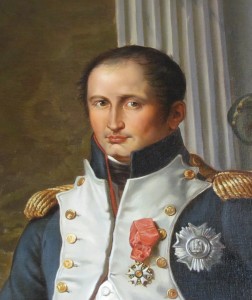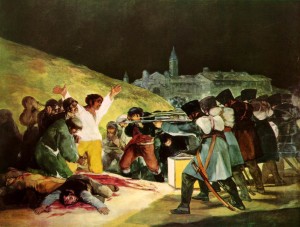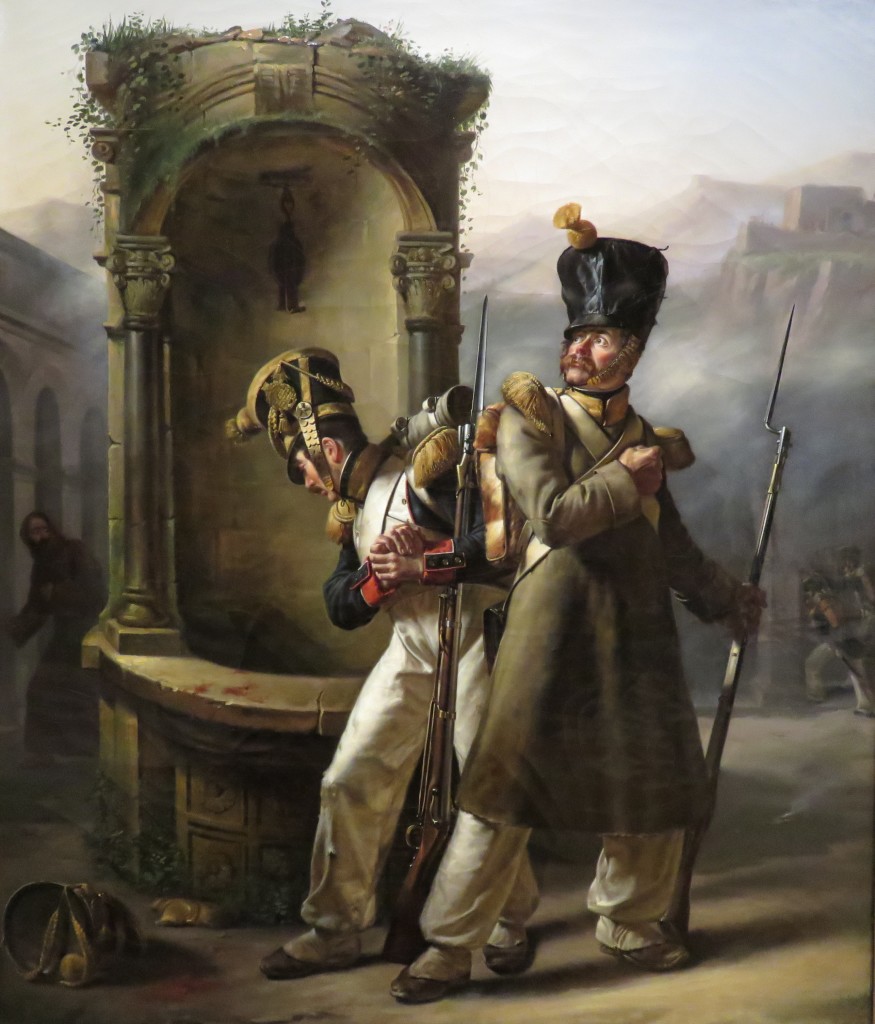Napoleon Bonaparte was a brilliant military and political leader, but that doesn’t mean that he didn’t make disastrous mistakes. In that regard, the Russian Campaign of 1812 deserves top billing. His misadventures in Spain, poignantly illustrated in this painting from the Virginia Museum of Fine Arts in Richmond, come in a close second.
I won’t presume to explain the Spanish debacle in detail, but for those who don’t know much about it, here’s a brief primer. When Napoleon came to power, Spain and France were allies, particularly in their opposition to England. In 1805, Napoleon’s French navy joined with the Spanish fleet to challenge Britain’s great naval hero, Admiral Lord Nelson, in the Battle of Trafalgar. Although Nelson died in the conflict, the Spanish and French were so thoroughly trounced that neither mounted a substantial navy again for years. Worse, the British established a continental foothold in Portugal.
 The Spanish-French alliance never recovered. First, Napoleon moved French troops onto Spanish territory, using a proposed joint invasion of Portugal as a pretext. Then, in 1808, Spain’s King Charles IV lost a feud with his eldest son and fled to France, expecting Napoleon to support him. Instead, Napoleon used the opportunity to depose both Charles and his son, the newly crowned Ferdinand VII. Installing his brother Joseph Bonaparte as king in their place, Napoleon made Spain a client state of the French Empire.
The Spanish-French alliance never recovered. First, Napoleon moved French troops onto Spanish territory, using a proposed joint invasion of Portugal as a pretext. Then, in 1808, Spain’s King Charles IV lost a feud with his eldest son and fled to France, expecting Napoleon to support him. Instead, Napoleon used the opportunity to depose both Charles and his son, the newly crowned Ferdinand VII. Installing his brother Joseph Bonaparte as king in their place, Napoleon made Spain a client state of the French Empire.
Joseph, usually a man of good intentions, tried to be an enlightened ruler. Unfortunately, only a small number of educated city dwellers, the so-called afrancesados, wanted modern reforms. Understandably, the Spanish population resented foreign intervention in their cultural traditions. The Spanish Catholic church, forced to end the Inquisition, called upon the peasants to save their souls from the invaders’ influence.
 Who can say who committed the first atrocity against the other side? Asymmetrical warfare ensued, as Spanish guerrilla fighters picked off, tortured and killed unwary French soldiers. The French responded with overwhelming force, sometimes against civilians. Francisco de Goya, initially the favored painter for Joseph Bonaparte’s court, depicted the French atrocities with a series of horrific images.
Who can say who committed the first atrocity against the other side? Asymmetrical warfare ensued, as Spanish guerrilla fighters picked off, tortured and killed unwary French soldiers. The French responded with overwhelming force, sometimes against civilians. Francisco de Goya, initially the favored painter for Joseph Bonaparte’s court, depicted the French atrocities with a series of horrific images.
The painting at the top of this blog is by a Frenchman, Jean-Claude Bonnefond (1796-1860). The information card at Virginia Museum of Fine Arts reads in part:
At a well in a courtyard of a monastery, two soldiers have just discovered a comrade’s epaulet and shako, or hat, and traces of a bloody struggle. A monk furtively retreats in the background. Although not a specific incident in the Peninsular War, this scene directly alludes to the tensions that flared between Napoleon and the Catholic church.
In 1813, the British led by Arthur Wellesley, the future Duke of Wellington, defeated the French troops in Spain. Joseph Bonaparte beat a hasty retreat across the Pyrenees and home to France.


Pingback: Finding Napoleon Bonaparte in Madrid – Part 2 - Finding Napoleon
Pingback: FINDING more NAPOLEON IN VIRGINIA - Margaret Rodenberg
Pingback: Finding Napoleon Bonaparte in Madrid – Part 2 - Margaret Rodenberg